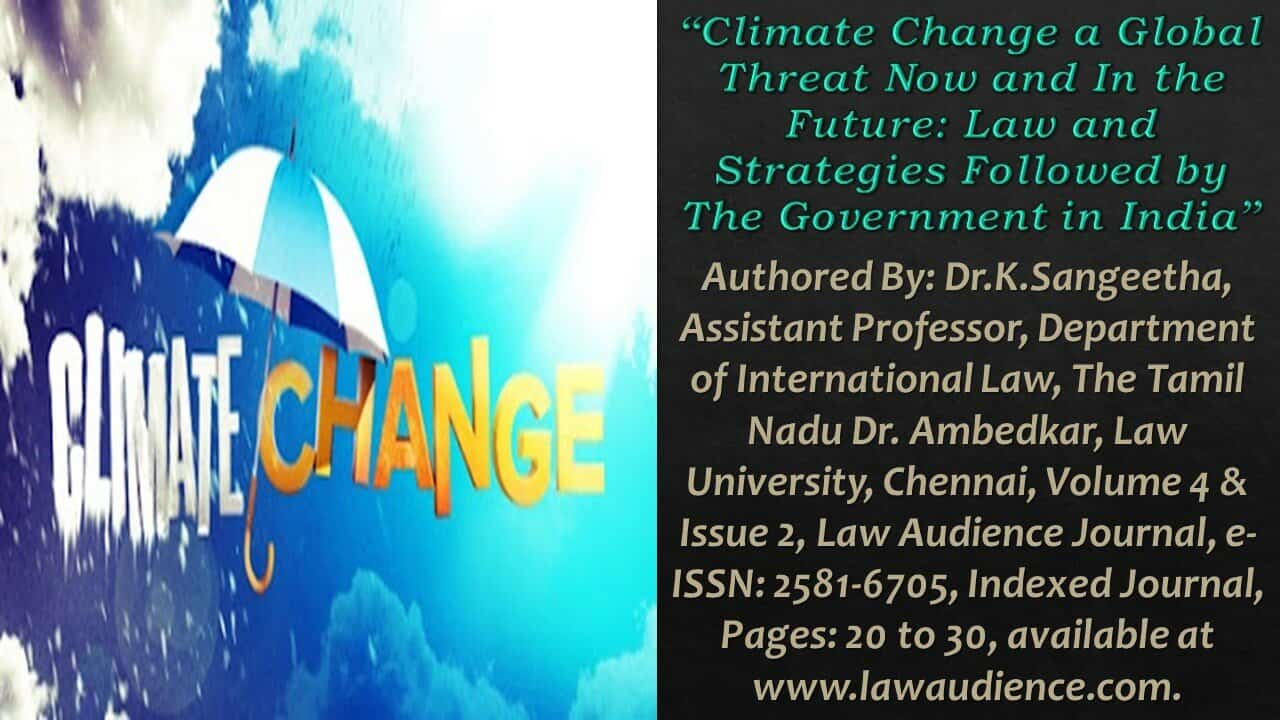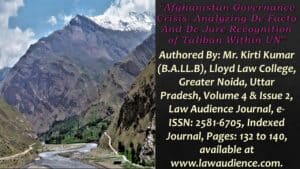Click here to download the full paper (PDF)
Authored By: Dr.K.Sangeetha, Assistant Professor, Department of International Law, The Tamil Nadu Dr. Ambedkar, Law University, Chennai,
Click here for Copyright Policy.
I. INTRODUCTION:
India is one of the most vulnerable Countries to Climate Change. About half of India’s population is dependent upon Agriculture or other Climate sensitive sectors. About 12% of India is flood prone while 16% is drought prone. India is now the Third largest emitter of Greenhouse gases in the World after China and the United States. India has almost tripled its annual emission between 1990 and 2009 from less than 600 metric tons to more than 1700 metric tons. India’s annual emissions of carbon oxide are projected to further increase almost 2.5 times to 4 times between 2008 to 2035. The Net Greenhouse gas emissions from India with land use, land use change and Forestry in 2007 were 1727.71 million tonnes of carbon dioxide. While the Energy sector constituted 8% of the net carbon dioxide emissions, Industry sector, Agriculture and Waste sector constituted 22%, 17% and 3% respectively of the net carbon oxide emission.
Thus, Climate change and Energy are now a focus of Local, State and National attention around the World. Though India earlier emphasized that it being a developing Country with historically low per capita emission rate, it is not responsible for past Greenhouse gas emissions, however, India has now become a key player in International negotiations and has begun implementing a diverse portfolio of Policies, Nationally and within Individual States, to improve energy efficiency, develop clean sources of energy and prepare for the impacts of Climate change.
Climate change is a Global Environmental problem which has been receiving intense Political attention both at Domestic and International levels. The United Nations Framework Convention on Climate Change (UNFCCC) defines ‘Climate Change’ as a change of Climate which is attributed directly or indirectly to human activity that alters the composition of the global atmosphere and which is in addition to natural climate variability observed over comparable time periods. India holds the dual distinction of being a victim as well as a contributor to climate change. It is the fourth largest carbon emitter, although its per capita emissions remain one of the lowest among emerging economies like China, Brazil and Mexico. Despite a huge development deficit, the World’s second most populous Country faces immense pressure globally to change its emission Trajectory. For instance, 58 per cent Indians rely solely on agriculture. Hence, any change in rain or temperature affects not only the Country’s Food security and also its Economy. In 2013, India, together with the Philippines and Cambodia, led the list of the most affected Countries, in the German Watch Global Climate Risk Index. This Article would discuss the Law, Policies and Strategy India adopts in formulating responses to Climate change. India already has several Substantive Laws for Prevention and Regulation of any activity that may cause Climate change both Domestically and Internationally.
I.I CLIMATE:
Climate is the pattern of variation in temperature, humidity, atmospheric pressure, wind, precipitation, atmospheric particle count and other meteorological variables in a given region over long periods. A region’s climate is generated by the climate system, which has five components: atmosphere, hydrosphere, cryosphere, lithosphere and biosphere. The climate of a location is affected by its latitude, terrain, and altitude as well as nearby water bodies and their currents.
I.II CLIMATE CHANGE:
Climate Change is normally known as the variation in Global and Regional Climates over time. It reflects changes in the variability or average state of the atmosphere over time scales ranging from decades to millions of years. The Earth’s Climate is dynamic and always changing through a natural cycle. What the World is more worried about today is that the changes that are occurring today have been speeded up. These changes may be caused by Natural processes, for example Continental rift, Volcanoes, Ocean currents, the Earth’s tilt, and Comets and Meteorites, as also those which are based on human activities or created by man. It is now well documented that in Global warming happening today, human activities contribute maximum to its causes. Climate Change presents to Society as a whole a wide range of threats, and a narrower range of opportunity, on the Political, Economic and Social level. It also poses questions and challenges for the Law. These Legal questions and challenges are relevant not just to the Lawyers; but it affects all members of a Society, whether as Policy makers, Business people, and Campaigners of all hues or Individual Citizens.
I.III GLOBAL WARMING:
Change in Climate and Global Warming is one of the most serious challenges mankind has faced having its implications even on realization of the Human rights. Even United Nations Human Right Council once observed, “Climate change poses immediate and far reaching threat to people and communities around the World and has implications for the full enjoyment of Human rights”. Global warming is primarily a problem of excessive Carbon dioxide in the Atmosphere. Atmosphere which acts as a blanket, trapping heat and warming the planet. As burning fossil fuels like coal, oil and natural gas for energy or cut down and burn forests to create pastures and plantations, carbon accumulates and overloads our atmosphere. Certain Waste Management and Agricultural practices also aggravate the problem by releasing other potent Global warming gases such as methane emitted from landfill and other waste dumps, during the process of oil drilling, coal mining and also from leaking gas pipe lines, and nitrous oxide emitted from fertilizer applications and leguminous plants such as beans and pulses.
Global warming is already under way with consequences that all face today as also shall tomorrow. Evidence of changes to the Earth’s Physical, Chemical and Biological processes is now evident on everybody. The Climate change increases the risk of injury, illness, deaths from the resulting heat waves, wild fires, intense storms and flood; the global food production is at risk; the availability of the precious water commodity, its access and even its quality is threatened; we are experiencing shift in season cycle and the extreme wet or extreme dry weather; land ice is shrinking which causes sea level to rise, endangering coastal communities and the ground water supply, making the ocean more acidic and thus threatening even the sea life; loss of natural habitat of the animals is resulting into making the species extinct; All have been experiencing droughts to floods; and the temperature, whether of ocean, water or ground is rising. The minimum temperature in Antarctica is recently reported to be above 00 Celcius and maximum at about 9.20 Celcius. In short, the impact of Global warming is on every sphere of life. Considering the huge impact of climate change on mankind, the United Nation referred the year 2009 as the ‘Year of Climate Change’.
II. INDIA AND CLIMATE CHANGE:
India is one of the most vulnerable countries to climate change. About half of India’s population is dependent upon agriculture or other climate sensitive sectors. About 12% of India is flood prone while 16% is drought prone. India is now the third largest emitter of greenhouse gases in the world after China and the United States. India has almost tripled its annual emission between 1990 and 2009 from less than 600 metric tons to more than 1700 metric tons. India’s annual emissions of carbon oxide are projected to further increase almost 2.5 times between 2008 to 2035. The net greenhouse gas emissions from India with land use, land use change and forestry in 2007 were 1727.71 million tonnes of carbon dioxide. While the energy sector constituted 8% of the net carbon dioxide emissions, industry sector, agriculture and waste sector constituted 22%, 17% and 3% respectively of the net carbon oxide emission. Thus, climate change and energy are now a focus of local, state and national attention around the world. Though India earlier emphasized that it being a developing country with historically low per capita emission rate, it is not responsible for past greenhouse gas emissions, however, India has now become a key player in international negotiations and has begun implementing a diverse portfolio of policies, nationally and within individual states, to improve energy efficiency, develop clean sources of energy and prepare for the impacts of climate change.
III. ENVIRONMENTAL LAWS AND POLICIES:
Even before India’s independence in the year 1947, several Environmental Legislations existed, but the real impetus for bringing about a well-developed framework came only after the UN Conference on the Human Environment (Stockholm, 1972). Under the influence of this declaration, the National Council for Environmental Policy and Planning within the Department of Science and Technology was set up in 1972. This Council later evolved into a full-fledged Ministry of Environment and Forests (MoEF) in 1985 which today is the apex administrative body in the country for regulating and ensuring Environmental protection. After the Stockholm Conference, in 1976, Constitutional sanction was given to Environmental concerns through the 42nd Amendment, which incorporated them into the Directive Principles of State Policy and Fundamental Rights and Duties. Then, what approach should India adopt in formulating Policy responses to Climate change, both Domestically and Internationally. In recent years, there has been a vibrant debate on this question. Though India already has several substantive laws for prevention and/or regulation of any activity that may cause Climate change, including:
III.I DURING THE BRITISH REGIME:
- Shore Nuisance (Bombay and Kolaba) Act, 1853
- The Indian Penal Code, 1860
- The Indian Easements Act, 1882
- The Fisheries Act, 1897
- The Factories Act, 1897
- The Bengal Smoke Nuisance Act, 1905
- The Bombay Smoke Nuisance Act, 1912
- The Elephant’s Preservation Act, 1879
- Wild Birds and Animals Protection Act, 1912.
III.II POST-INDEPENDENCE OF INDIA:
- Setting up of National Council for Environmental Policy and Planning was set up in 1972 which was later evolved into Ministry of Environment and Forests (MoEF) in 1985.
- Policy Statement for Abatement of Pollution and the National Conservation Strategy and Policy Statement on Environment and Development brought out by the MoEF in 1992
- EAP (Environmental Action Programme) was formulated in 1993 with the objective of improving environmental services and integrating environmental considerations into development programmes.
- National Environment Policy, 2006
- Water (Prevention and Control of Pollution) Act, 1974
- Water (Prevention and Control of Pollution) Cess Act, 1977
- Air (Prevention and Control of Pollution) Act, 1981
- Atomic Energy Act of 1982
- Motor Vehicles Act ,1988
- The Wildlife (Protection) Act, 1972
- The Forest (Conservation) Act, 1980
- Environment (Protection) Act, 1986 (EPA)
- The National Environment Appellate Authority Act, 1997
- Public Liability Insurance Act (PLIA), 1991
- National Environment Tribunal Act, 1995
- Environment Impact Assessment (EIA) Notifications,
However, a specific guiding national strategy that addresses India’s development concerns and mitigation and adaptation challenges was also important. This was the frame work that was laid out in the ‘National Action Plan on Climate Change (NAPCC), Prime Minister’s Council for Climate Change, Government of India (2008)’ and its subsidiary Eight Missions:
- National Solar Mission (started in 2010);
- National Mission for Enhanced Energy Efficiency (approved in 2009);
- National Mission on Sustainable Habitat (approved in 2011);
- National Water Mission;
- National Mission for Sustaining the Himalayan Ecosystem (approved in 2014);
- National Mission for a Green India (approved in 2014);
- National Mission for Sustainable Agriculture (approved in 2010); and
- National Mission on Strategic Knowledge for Climate Change.
The Eight Missions listed above are expected to advance India’s development and define its approach to climate mitigation and adaption while satisfying the principles of the National Action Plan on Climate Change. Besides the above stated Legislations, rules and policies, there are several other plans and incentives by the Governments for Energy Conservation and to mitigate impact of Climate change. Each State is now also in the process of developing State Action Plans on climate change with recommendations on how mitigation and adaptation can be main streamed into development Policy. Individual Ministries and Agencies have also developed their respective Mission documents and policies for addressing Climate change. It is hoped that the National Climate Change Strategy reported to be in the making shall be soon ready for its implementation.
IV. ENVIRONMENT AND INDIAN CONSTITUTION:
The Indian Constitution is one of the few in the World that contains specific provisions on the Environment. The Directive Principles of State Policy and the Fundamental Duties explicitly enunciate the National commitment to protect and improve the Environment. Three Constitutional provisions bear directly on Environmental matters.
- First and foremost, Article 21 states: “No person shall be deprived of his life or personal liberty except according to procedure established by law.” In Subhash Kumar v. State of Bihar[1], and Virendra Gaur v. State of Haryana[2], the Supreme Court recognized several liberties that are implied by Article 21, including the right to a healthy Environment. The State High Courts have followed the Supreme Court’s lead, and virtually all now recognize an environmental dimension to Article 21.
- Second, Article 48A requires that “the State shall endeavor to protect and improve the environment and to safeguard the Forests and Wild life of the Country.”
- Third, Article 51A establishes that, “ it shall be the duty of every Citizen of India to protect and improve the Natural Environment including Forests, Lakes, Rivers, and Wild life and to have compassion for Living Creatures.”
Though these latter two provisions have traditionally been incapable of enforcement through the exercise of Writ jurisdiction, Courts have increasingly relied upon them for support in resolving Environmental Controversies.
V. ROLE OF JUDICIARY:
Indian Environmental Law has seen considerable development in the last over three decades. Most of the principles under which Environmental Law works in India today were assembled over the last over three decades. A predominant share of essence of the existing Law relating to the Environment has developed through careful Judicial thinking in the Supreme Court and the High Courts. In the process of adjudication on the Environmental matters, the Supreme Court has actually come up with the new pattern of “Judge driven implementation” of Environmental administration in India. The Court has played a pivotal role in interpreting those Laws and has successfully isolated specific Environmental Law principles upon the interpretation of Indian statutes and the Constitution, combined with a liberal view towards ensuring Social Justice and the protection of Human rights. So, when one analyses the Indian Environmental Law’s development path, one will surely have to keep in mind the concept of Judicial Law Making. The orders and directions of the Supreme Court cover a wide range of areas whether it be Air, Water, Solid Waste or Hazardous Waste. The field covered is very vast such as Vehicular pollution, Pollution by Industries, Depletion of Forests, Illegal Felling of Trees, dumping of Hazardous Waste, Pollution of Rivers, Illegal Mining etc. The list is unending. The Supreme Court has passed orders for closure of polluting Industries and Environmentally harmful aqua farms, mandated cleaner fuel for vehicles, stopped illegal mining activity, and protected Forests and Architectural treasures like Taj Mahal. Some of the judgments wherein various principles relating to Environment Law were Judicially recognised are worth mentioning:
- In MC Mehta vs. UOI,[3] the Hon’ble Supreme Court in its order dated 24-10-2018, decided that no motor vehicle conforming to the emission standard BS-IV shall be sold or registered in the entire country with effect from 01.04.2020, and the same shall be substituted by BS-VI compliant vehicles. Certain orders were also passed in therein with respect to imposing ban on diesel vehicles to curb the air pollution.
- In MC Mehta vs. UOI,[4] (Oleum Gas Leak case), the Supreme Court formulated an indigenous jurisprudence of Absolute Liability in compensating the victims of pollution caused by hazardous and inherently dangerous Industries.
- In M.C. Mehta vs. Union of India,[5] wherein the issue of pollution of the Ganga river by the hazardous industries located on its banks was highlighted, the Hon’ble Supreme Court ordered the closure of a number of polluting Tanneries near Kanpur.
- The Hon’ble Supreme Court in the case of TN Godavarman Thirumulpad vs. Union of India and Ors.,[6] dealing with the issue of livelihood of Forest dwellers in the Nilgiri region of Tamil Nadu being affected by the destruction of Forests, passed a series of directions.
- Ganesh Wood Products vs. State of Himachal Pradesh,[7] this judgment expanded the definition of forest to its ordinary dictionary meaning, and imposed a ban on all non–forest activities on forest land without prior approval of the Central Government and directions were given to constitute Expert Committee in each State to identify forests and for Movement and disposal of timber, and for constitution of a High-Power Committee to deal with Forest.
- MC Mehta vs. Kamal Nath,[8] is a case where there was an attempt to divert the flow of a river for augmenting facilities in a motel. The Supreme Court interfered by recognizing the Public Trust Doctrine and held that the State and its Instrumentalities as trustees have a duty to protect and preserve natural resources such as Rivers, Lakes, Forests, Open spaces and other Common Property Resources.
- MI Builders Pvt. Ltd. vs. Radhey Shyam Sahu,[9] wherein also the Hon’ble Supreme Court applied Public Trust Doctrine and asked a City Development Authority to dismantle an underground market built beneath a garden of historical importance.
- In Vellore Citizens Welfare Forum vs. UOI,[10] the Supreme Court adopted the Precautionary Principle to check pollution of underground water caused by the Leather Industries in Tamil Nadu. The Hon’ble Court also opined the Precautionary Principle and the Polluter Pays Principle are part of the Environmental Law of the C
- In Indian council for Enviro Legal Action vs. UOI,[11] the Supreme Court reiterated and applied the principle to restore the environment of a village whose Ecology had been destroyed by the sludge left out by the trial run of the Industries permitted to produce the ‘H’ acid.
- In State of Himachal Pradesh vs. Ganesh Wood Products,[12] the Supreme Court invalidated Forest based Industry, recognizing the Principle of Inter–Generational Equity as being central to the Conservation of Forest resources and Sustainable Development.
- The Hon’ble Supreme Court also noted in Indian Council for Enviro Legal Action vs. Union of India (CRZ Notification case),[13] that the Principle of Sustainable Development would be violated if there were a substantial adverse Ecological effect caused by Industry.
- The Principle of Sustainable Development was also recognized by the Supreme Court of India in the M.C. Mehta vs. Union of India (Taj Trapezium case),[14]
- In Enkay Plastics Pvt. Ltd. v Union of India (UOI) and Ors.,[15] the Delhi High Court upheld the order of closure of certain units which were manufacturing Urea Formaldehyde Powder in thickly populated residential areas and held that the direction to close down such Industries cannot be treated as violative of Article 19 of the Constitution as it is in the larger public interest to prevent any danger to the health and life of the public at large.
- Amongst others, the Delhi High Court has also directed for preservation of ancient monuments of historical importance, restoration of water bodies in and around Delhi and in maintaining the forest ridge area in Delhi which are the lungs of the City.
VI. CONCLUSION:
As a Country, accustomed to Natural Climatic Variability, there is always a tendency to think that we have seen it all before and there is nothing new. But present-day Climate change is different. It is now well accepted that human beings have interfered with basic natural cycles, such as energy and water cycles, which have kept our planet in equilibrium for Millennia. Carbon dioxide levels are now at their highest. It is projected that at present rates of increase of emissions, the world is heading to a 40 Celsius rise by the end of the century, which may not only spell doom for wild wife and sea creatures but also significant stress on everything from human health to livelihood Security and Economic development. In other words, our life, our very existence may be at stake. There is much that can be done. Addressing Climate change means small, medium and big actions. All can act in the full range of roles that people occupy as Workers, Students, Consumers, Investors, Educators, Entrepreneurs and as Citizens. And one can act in all of our spheres of influence our Homes, Schools, Work places and in Public life. All can work to get out the message that Climate change is real, it is happening and together need to take action now to address it. Remember, that all are more than just Consumers. Our leaders need regular reminding from us as Citizens that all will support any courageous action on Climate change to avert risk into opportunity.
Cite this article as:
Dr.K.Sangeetha, “Climate Change a Global Threat Now and In the Future: Law and Strategies Followed by The Government in India”, Vol.4 & Issue 2, Law Audience Journal (e-ISSN: 2581-6705), Pages 20 to 30 (23rd July 2022), available at https://www.lawaudience.com/climate-change-a-global-threat-now-and-in-the-future-law-and-strategies-followed-by-the-government-in-india/.
Footnotes & References:
[1] A.I.R 1991 SC 420.
[2] (1995) 2 SCC 577.
[3] WP (C) 13029/1985.
[4] AIR 1987 SC 1086.
[5] AIR 1988 SCR (2) 538.
[6] W.P.(C) No. 202 of 1995.
[7] AIR 1996 SC 149.
[8] (1996) 1 SCC 38.
[9] AIR 1996 SC 2468.
[10] AIR 1996 SC 2718.
[11] AIR 1996 SC 1446.
[12] AIR 1996 SC 149.
[13] (1996) 5 SCC 281.
[14] AIR 1997 SC 734.
[15] 2000(56) DRJ 828.




